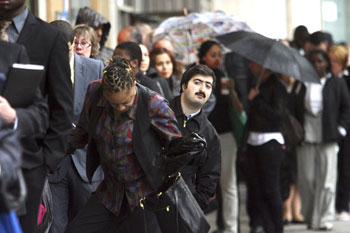

Vol. 74/No. 22 June 7, 2010

|
| AP Photo/Mary Altaffer |
| Workers line up outside “Putting New Yorkers Back to Work” job fair in New York City May 18. High unemployment and underemployment are behind rising residential foreclosures. |
According to the Mortgage Bankers Association, in the first quarter of 2010, a record one out of every seven U.S. mortgage holders was either behind in their payments or facing foreclosure—some 7.3 million households. More than 10 percent had missed at least one payment in this period, up from 9.1 percent a year ago.
Those failing to make at least three months of payments or in foreclosure are 8 percent of U.S. mortgage holders, about 4.3 million people. Growing numbers of them are staying in their homes for longer periods of time before eviction. Banks are allowing this to avoid “swamping the housing market with too many foreclosed homes all at once,” further depressing home prices, noted the Wall Street Journal.
Initially working people with so-called subprime loans, which had rising interest rates, were the ones mostly facing foreclosure. This has now spread to those with all kinds of loans. More than one-third of new foreclosures in the first quarter were mortgage holders with conventional fixed-rate loans, more than double those with subprime loans.
Commercial real estate is also facing a deep crisis. Some $1.4 trillion in commercial mortgage loans will become due over the next four years “with balloon payments due at expiration,” reported Investor’s Business Daily. The largest of these loans are held by some of the biggest banks—J.P. Morgan, Bank of America, and Wells Fargo.
Declining housing prices
High unemployment and underemployment, officially at 17.1 percent, account for rising numbers of residential foreclosures. House prices continue to decline in many areas.
According to figures released by New RealtyTrac, compared to 2007 housing prices are down about 50 percent in Riverside and Sacramento, California, and in Orlando, Florida. In Palm Coast and Fort Myers, Florida, they’re down more than 60 percent.
With declining house prices, about one-quarter of all mortgage holders owe more than their property is currently worth.
The Barack Obama administration’s $75 billion plan to “prevent foreclosures” has done little to alleviate the crisis for working people. The “Home Affordable Modification Program,” launched a year ago, pays banks to lower mortgage payments. Of the 1.2 million house owners enrolled in the program, 23 percent dropped out last year. Only 25 percent received permanent loan modifications, with more than half redefaulting on their loans within nine months.
The government bailout of the biggest banks last year transferred more than $1 trillion of those institutions’ largely worthless mortgage securities onto the federal government balance sheet. Administration officials are now trying to decide what can be done—if anything—with these “assets.” A Federal Reserve meeting at the end of April ruled out attempts to sell off this debt “until the economic recovery was well established,” reported the minutes of its meeting.
Meanwhile, the pace of bank failures is increasing. So far 72 banks have collapsed this year, more than double the number by this time last year. A total of 775 banks, or one-tenth of all U.S. banks, are on the Federal Deposit Insurance Corporation’s (FDIC) list of “problem” institutions. The FDIC, which insures about $5 trillion of deposits, currently has a balance of minus $20.7 billion as of the end of the first quarter, reported the Journal.
In another development, Fannie Mae requested another $8.4 billion from the U.S. Treasury, reporting its 12th consecutive quarterly loss. Several days earlier Freddie Mac said it needed another $10.6 billion. The federal government seized control of these housing mortgage giants in September 2008 to avert their collapse. Last December it lifted the $200 billion limit it had placed on their bailouts.
The Federal Housing Administration, Fannie Mae and Freddie Mac guarantee more than 90 percent of all housing mortgages in the United States.
Front page (for this issue) |
Home |
Text-version home